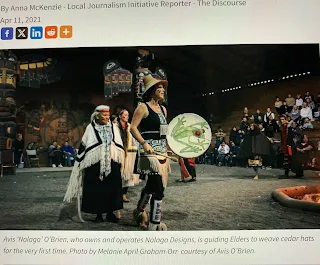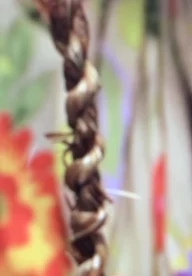https://drive.google.com/drive/folders/17xOE9b-lJ570lQXz-EaWosB8e8Qzjw9o?usp=drive_link
Wednesday, March 27, 2024
Monday, March 11, 2024
Final Project Draft
https://docs.google.com/document/d/1IFJ5MoBbvcAfM7Sa-2tdfIwXnK2VH7h_/edit?usp=drive_link&ouid=104323376055760014489&rtpof=true&sd=true
Saturday, March 9, 2024
Week 9: Mathematics & traditional and contemporary practices of making and doing
Reading
As I reflect on Avis O’Brien’s captivating journey, a Haida
and Kwakwa̱ka̱ʼwakw woman weaving her way back to her cultural roots through
cedar, I am struck by two significant stops in her transformative narrative.
First Stop: Reconnecting through Cedar Medicine
The initial turning point for O’Brien was in 2010 when she
embraced the art of cedar weaving under the guidance of her sister, Meghann
O’Brien. Before this, O’Brien harbored a sense of disconnection and shame about
her identity, a product of historical impacts on Indigenous cultures. The power
of cedar, described as sacred medicine, became the key that unlocked the door
to her cultural heritage. This moment stands out as a powerful testament to the
healing potential embedded within indigenous practices. O’Brien's experience
underscores the idea that cultural reclamation can be a profound path to
self-discovery and reconnection.
Second Stop: Weaving as Cultural Resilience
The historical context woven into O’Brien’s narrative
reveals the deliberate suppression of Indigenous cultural practices by the
Canadian government. The ban on Potlatches, a central element of First Nations'
cultural and economic identity, exemplifies a systematic effort to erase
indigenous cultures. As one of these suppressed practices, Weaving slept
through those challenging times, but O’Brien sees its reawakening as an act of
resilience. By facilitating cedar weaving workshops, she actively supports
Elders in reclaiming what was taken from them throughout history. This stop on
O’Brien’s journey highlights the enduring strength of Indigenous cultures and
the power of individuals like her in revitalizing and preserving these
traditions.
Question for Discussion:
- In
what ways does the intersection of cultural practices, such as cedar
weaving, contribute to intergenerational healing and the preservation of
Indigenous identity?
APTN
article, Apr 11, 2021: ‘The spirit of the medicine will lead
us back’: How Avis O’Brien is guiding Elders to weave their first cedar hats
Activity
This week's handmade
rope-making exploration has been a delightful revelation, expanding my
perspective on the mathematics embedded in a seemingly simple craft. As someone
who frequently uses ropes but never considered their potential for teaching
mathematics, this experience was an eye-opener. Engaging in the tactile process
of creating 2-ply twine with two scarves felt like an intimate connection to a
timeless human tradition, even though I quickly made the S twist and struggled
with the Z twist. Sharon Kellis's insightful mention in the video of the
possibility of creating a rope with anything. Also, she made the connection
between rope making and the foundation of the new technology, as iPads added an
extra layer of fascination to this age-old craft. Physically manipulating
materials brought a profound sense of connection to our ancestors, instilling
in me a grounding experience that resonates with the present.
When I made the S
shape, I explored the mathematical patterning woven into each twist and turn of
the scarves. It was a fascinating journey into the hidden complexities of the
craft. As I twisted away from me, I marveled at the symmetry and uniformity of
the resulting rope – all manifesting mathematical principles. The tension in my
hands hinted at the possibility of exploring concepts like symmetry, geometry,
and basic algebraic relations. It is intriguing how making rope can unveil a
world of mathematical beauty, creating a bridge between the tactile and the
abstract.
Indeed, handmade
rope-making can be integrated into the curriculum, which opens doors to many
enriching possibilities. Weaving the historical and cultural context of rope-making
into lessons serves as a bridge, connecting ancient practices with contemporary
mathematical understanding. For instance, students can be introduced to the
mathematical concepts of symmetry, geometry, and algebraic relations through
hands-on activities that bring these principles to life and engage students in
a multisensory learning experience. Emphasizing the tactile sensation of rope
making, the visual observation of patterns, and the kinesthetic experience of
twisting creates holistic learning styles, making mathematical concepts more
accessible and engaging.
In summary, handmade
rope-making emerges as a powerful interdisciplinary tool, seamlessly weaving
together history, culture, and mathematics. As educators, incorporating this
craft into our teaching practices provides students with a unique and immersive
learning experience, fostering a deep appreciation for the mathematical
principles at play and the cultural significance of traditional crafts. As I
reflect on this exploration, I am left wondering what unique perspectives students
might bring to this age-old craft and how it could become a gateway for them to
appreciate the mathematical and cultural significance of hands-on learning.
Top of Form
1) The art and geometry of rope
making and yarn plying
2) Weaving the Bridge at Q’eswachaka
Saturday, March 2, 2024
Week 8: Mathematics & fibre arts, fashion arts and culinary arts
Reflection on the Reading:
Exploring Ratios and
Sequences with Mathematically Layered Beverages by Andrea Johanna
Hawksley
As I delved into Andrea Johanna Hawksley's exploration of
teaching ratios and sequences through layered beverages, I was captivated by
the innovative approach to blending math with culinary delight. Two prominent
stops in this reading stood out to me, offering unique insights into the
intersection of mathematics and food.
The first notable stop is the introduction of simple
two-layered beverages, a clever tool to enhance comfort with fractions and
ratios. The author seamlessly integrates mathematics into cooking, highlighting
the strict ratios in recipes and emphasizing the importance of understanding
fractions. The example of expressing sweetness as a ratio between layers—3:5,
for instance—creates a tangible link between the abstract world of numbers and
the delicious experience of consuming layered drinks.
The second stop takes me into exploring sequences using
beverages with many layers. The limitation that each layer must be less dense
than the previous one narrows down the feasible sequences, introducing a
fascinating challenge. The author introduces sequences like the Fibonacci
sequence, demonstrating how the layers' proportions can mirror the sequence's
mathematical properties. Creating a Fibonacci lemonade, where the intensity of
flavors increases exponentially, adds a delightful twist to the exploration.
These stops underscore the dynamic relationship between
mathematics and the sensory experience of consuming layered beverages. The
interactive nature of the workshop engages participants in hands-on
calculations, transforming the often abstract and challenging concept of
fractions into a practical, enjoyable exercise. The layered drinks not only
serve as visual aids but also as tangible representations of mathematical
principles.
Now, turning to potential questions:
- Can
you think of other mathematical concepts that could be effectively taught
through food, similar to the approach described in the reading?
- How might these concepts be translated
into a hands-on, enjoyable learning experience?
Andrea Hawksley (Bridges 2015) Exploring ratios and
sequences with mathematically layered beverages
Top of Form
Activity
Reflection on Personal Exploration:
Miura Ori Origami and Mathematically-Interesting Shoe
Lacing
Embarking on the journey of trying out Miura Ori Origami and
exploring mathematically interesting ways of lacing shoes has been a
fascinating and eye-opening experience. Though seemingly unrelated, both
activities offered a unique perspective on the interconnectedness of
mathematics with everyday objects and artistic creations.
Miura Ori Origami: Unraveling Mathematical Beauty
Attempting the Miura Ori Origami technique, as demonstrated
by Uyen Nguyen, was a delightful immersion into the world of mathematical
elegance embedded in fashion design. The step-by-step video instructions (B)
unveiled a mesmerizing sequence of folds that transformed a flat piece of paper
into a three-dimensional masterpiece. The recurring patterns of triangles and
parallelograms became apparent, showcasing the precision and symmetry inherent
in the origami art form.
What struck me the most was the mathematical precision
required to achieve the final result. The interconnected folds carefully
considered angles, proportions, and geometric relationships. It was a reminder
that even in the seemingly free-flowing world of art and design, mathematics
plays a pivotal role in creating order and structure.
Shoe Lacing: Tying the Knot
with Numbers
Shifting gears to the world of shoelaces, I delved into the
Mathologer video, uncovering the intricate mathematics behind different lacing
patterns. Before this exploration, I never thought much about the mathematical
aspects of something as mundane as shoe laces. The video opened my eyes to the
complexity and diversity of lacing techniques, each with its unique
mathematical properties.
The revelation that the popular criss-cross and zig-zag
lacing patterns are not just aesthetic choices but have mathematical
underpinnings was intriguing. The emphasis on tight lacing and the connection
to mathematical concepts, such as the contribution of each eyelet and the rapid
increase in possibilities with more eyelets, showcased the intricate
relationship between mathematics and seemingly unrelated daily activities.
In conclusion, both activities underscored the omnipresence
of mathematics in our lives, whether in the meticulous folds of an origami
creation or the efficient lacing of shoes. These experiences have heightened my
appreciation for the beauty and functionality that mathematics brings to even
the most ordinary aspects of our daily routines.
Questions to ponder:
- Consider
incorporating mathematical concepts into art forms or routine activities.
How do you think this integration could enhance learning experiences and
make mathematical ideas more accessible and engaging for a broader
audience?
Miura Ori - Traditionelle Miura-Faltung
https://www.youtube.com/watch?app=desktop&v=EEGmnKKKhrk
What is the best way to lace your shoes? Dream proof.
https://www.youtube.com/watch?v=CSw3Wqoim5M
Trigonometry Flex your Muscle!
https://drive.google.com/drive/folders/17xOE9b-lJ570lQXz-EaWosB8e8Qzjw9o?usp=drive_link
-
In our exploration of mathematics, it is crucial to question the perceived separation between mathematical concepts and the physical world, ...
-
Reflection on the Reading: Exploring Ratios and Sequences with Mathematically Layered Beverages by Andrea Johanna Hawksley As I delved i...
-
Here is the link Outline Prosal Final Feb 12.docx - Google Docs













